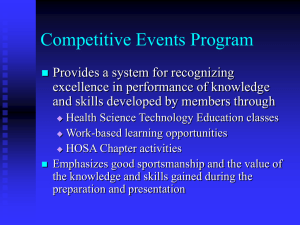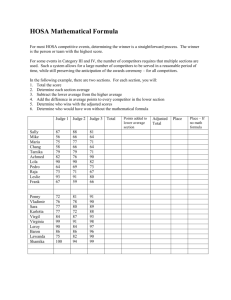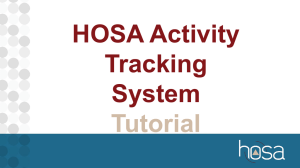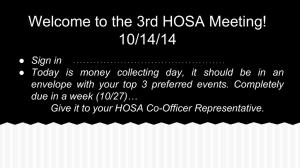Tips for Introducing HOSA in the Classroom
advertisement
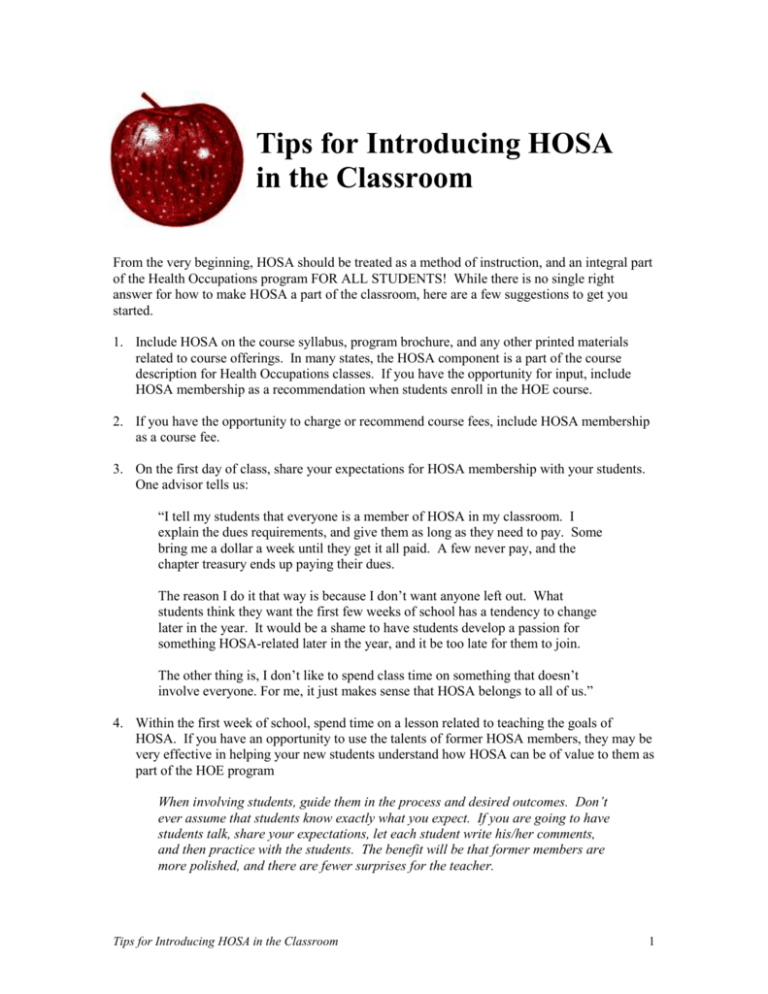
Tips for Introducing HOSA in the Classroom From the very beginning, HOSA should be treated as a method of instruction, and an integral part of the Health Occupations program FOR ALL STUDENTS! While there is no single right answer for how to make HOSA a part of the classroom, here are a few suggestions to get you started. 1. Include HOSA on the course syllabus, program brochure, and any other printed materials related to course offerings. In many states, the HOSA component is a part of the course description for Health Occupations classes. If you have the opportunity for input, include HOSA membership as a recommendation when students enroll in the HOE course. 2. If you have the opportunity to charge or recommend course fees, include HOSA membership as a course fee. 3. On the first day of class, share your expectations for HOSA membership with your students. One advisor tells us: “I tell my students that everyone is a member of HOSA in my classroom. I explain the dues requirements, and give them as long as they need to pay. Some bring me a dollar a week until they get it all paid. A few never pay, and the chapter treasury ends up paying their dues. The reason I do it that way is because I don’t want anyone left out. What students think they want the first few weeks of school has a tendency to change later in the year. It would be a shame to have students develop a passion for something HOSA-related later in the year, and it be too late for them to join. The other thing is, I don’t like to spend class time on something that doesn’t involve everyone. For me, it just makes sense that HOSA belongs to all of us.” 4. Within the first week of school, spend time on a lesson related to teaching the goals of HOSA. If you have an opportunity to use the talents of former HOSA members, they may be very effective in helping your new students understand how HOSA can be of value to them as part of the HOE program When involving students, guide them in the process and desired outcomes. Don’t ever assume that students know exactly what you expect. If you are going to have students talk, share your expectations, let each student write his/her comments, and then practice with the students. The benefit will be that former members are more polished, and there are fewer surprises for the teacher. Tips for Introducing HOSA in the Classroom 1 5. Encourage students to visit the HOSA web site. There is a web evaluation in the HOSA 101 program that you can copy and give to students. Have them evaluate the web site and make recommendations. Even better, have them develop a chapter web site, or add to an existing one. Have them create a page on their web site to report on classroom learning, or create links to valuable medical sites. 6. Use HOSA as a reward at the end of a class period for completing classroom objectives. One advisor in particular would always postpone HOSA business until after lesson objectives had been accomplished. This method motivates students to stay on task in the classroom in order to have time for the “fun stuff” that HOSA provides. 7. In many schools, the HOSA officer team includes an elected member from every Health Occupations class. Such a format assures that there is a student in every class to share announcements and keep class members updated on HOSA activities. 8. Introduce HOSA competitive events in the classroom by using the procedures for class activities and the rating sheets as rubrics. Most competitive events are easily adaptable to course objectives, particularly those in Categories III and IV. Playing “Medical Spelling” as a review for a test, or using “biomedical debate” to encourage students to analyze a health issue, can reinforce course content in an exciting way. Use of competitive events in the classroom will help HOSA members identify their interests, and it’s fun! 9. HOSA provides a great opportunity for hosting guest speakers, both in the classroom and during chapter meetings. HOSA members should be given the responsibility to introduce speakers, thank them after the speaking, and present them with a certificate or token of appreciation from HOSA. 10. Use HOSA to make career connections for students. At the high school level, find out every student’s career goal on the first day of class. Use HOSA to support workbased learning opportunities, either through participation in skill events, field trips to appropriate medical facilities, service-learning as volunteers in health care agencies, or by arranging shadowing assignments. For the postsecondary/collegiate student, HOSA skill and knowledge competitive events can help prepare students for licensure and certification exams and tests after they complete their professional programs. One teacher tells us: “All of our EMT students compete in the state HOSA EMT event. The HOSA event is similar to the EMT National Registry Skill Assessment. Since becoming involved in HOSA, 100% of our students have passed the EMT Assessment. The HOSA experience makes a difference.” And now a little advice… Respect the value of a “student” led organization. HOSA is about students taking initiative and responsibility. Guide them toward success but don’t push too hard. Help HOSA members set their own goals and then plan appropriately to achieve them. Look in the mirror on occasion and ask yourself the question – “Am I doing enough, or too much?” Tips for Introducing HOSA in the Classroom 2 Read the directions over and over and over. Almost everything you need to know to manage a HOSA chapter is in writing somewhere. Know your school policies, county rules, and state requirements for involvement in HOSA activities. Understand that high school kids are “kids”, and college students have a lot going on in their lives. Family comes first, then schoolwork, and then HOSA. Accept the fact that sometimes they get scared. Sometimes they change their minds. Sometimes they make bad choices. You may work with 100 students and only make a big difference for a few – but what a difference you’ll make for those few. It’s worth it. Fundraising can drive an advisor crazy. Talk to experienced advisors to find out suggestions for managing fundraising. Keep it simple, and be sure not to give HOSA members more of a financial burden than they can manage. (One advisor kept checking out candy to a student but never collected any. When the fundraiser was over, the student owed $140. School administrators had a difficult time understanding why the advisor continued to give the student candy.) Don’t try to save the world. The responsibility for success in HOSA should be the burden of the HOSA member and not the advisor. Support is a wonderful thing, but advisors who do too much take away the personal satisfaction a HOSA member feels when he or she works hard to accomplish a goal – and succeeds. Tips for Introducing HOSA in the Classroom 3


